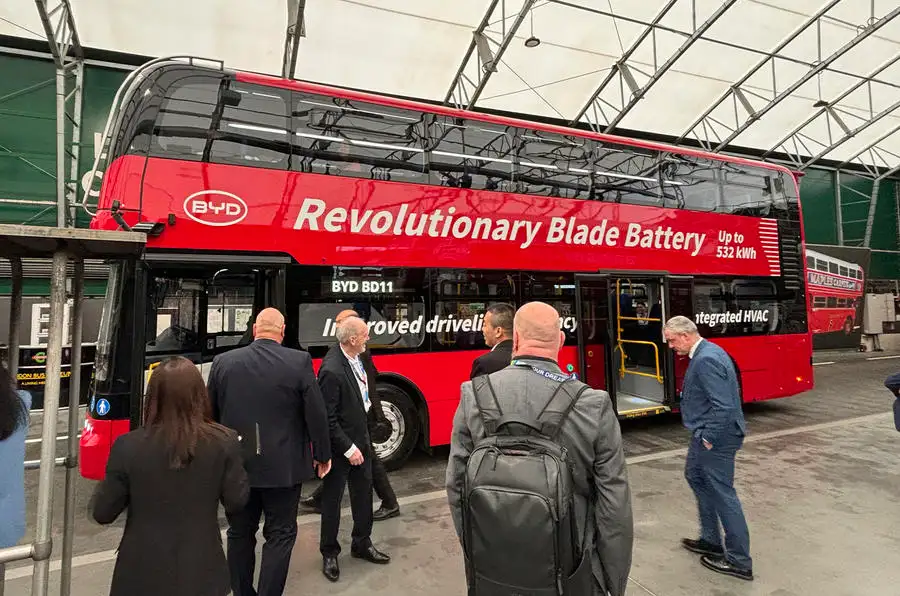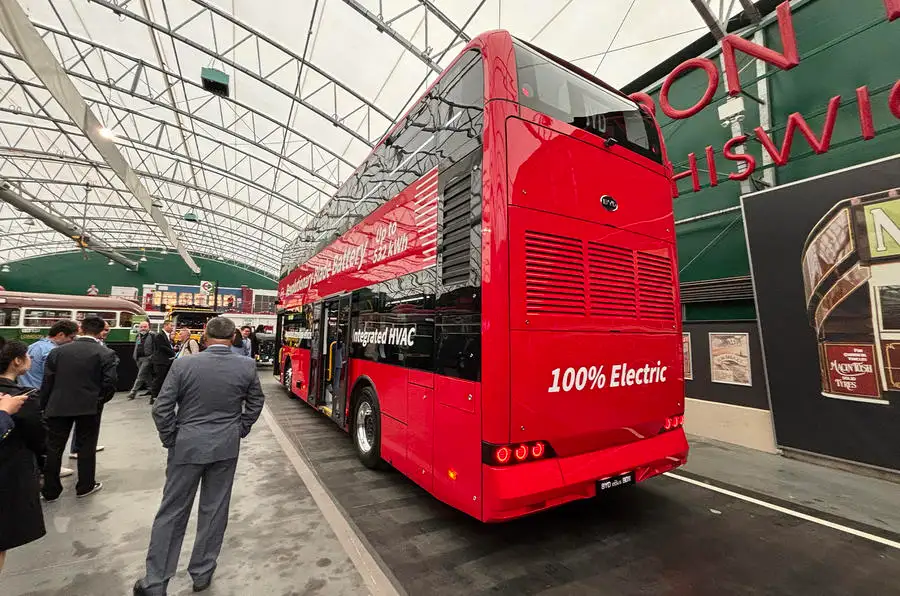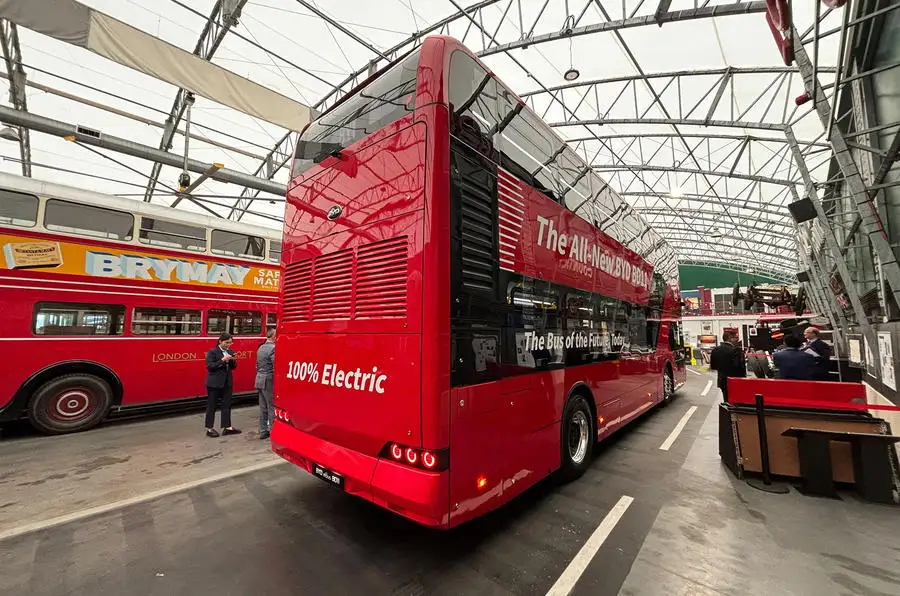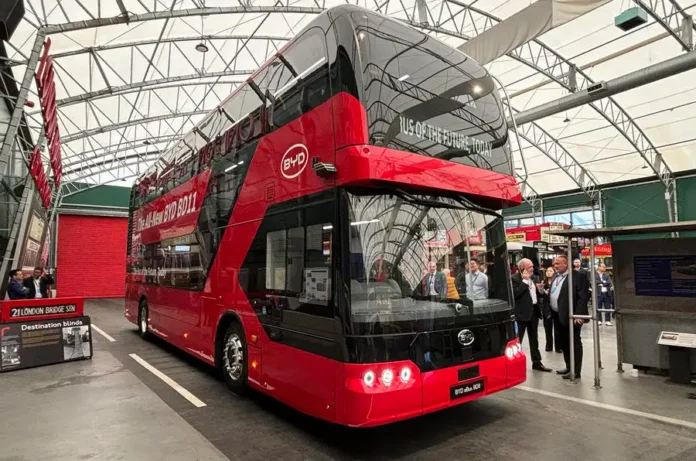With the arrival of BYD’s new BD11 electric double-decker bus, London’s famous red double-decker buses are about to see a dramatic makeover. In line with the objective of having a fleet of all electric buses by 2030, this initiative represents a turning point in the city’s transition to sustainable public transport. The details of BYD’s innovative bus are explored in this article, along with any possible effects on London’s public transport system and wider ramifications for urban transportation.

BYD’s BD11: A New Era for Public Transport in London
For many years, the red “Boris Bus,” named for the late mayor Boris Johnson, has been a common sight on London’s streets. Nevertheless, a more environmentally friendly substitute is going to gradually replace these hybrid buses, which are distinguished by their unique appearance and partially electric propulsion. The ageing fleet of buses will be replaced by the BYD BD11, an innovative electric double-decker bus with a 400+ mile range.
Also Read :- BYD’s Record May: Price Drop Drive Sales Growth in 2024
Revealing Features and Specifications of BYD BD11 EV Bus
Innovative Battery Technology
Blade battery technology from BYD is the brains behind the BD11. With a 532kWh battery, the bus can go up to 400 miles on a single charge—the biggest of any commercial vehicle currently on the market in the UK. With a range that is twice as long as the hybrid London buses now operate in a day, the BD11 can run continuously without requiring a recharge. BYD’s innovative e-Platform 3.0 incorporates the battery as a structural element to improve ride quality and vehicle stiffness.
Outstanding Capabilities for Charging
The BD11’s charging versatility is one of its best features. Depots and public stations include standard charging connections as well as a 500kW pantograph (overhead) connection for charging the bus. The battery may be charged quickly because to its dual charging feature, going from 0% to 100% in just two hours. The bus may also connect to many chargers simultaneously, which increases charging speed and reduces downtime.
Comfort and Capacity of Passengers
In order to maximise passenger comfort, the BD11 was created. Depending on the arrangement, it may accommodate up to 90 passengers, providing plenty of room for commuters. Its 8.0-meter turning radius and the use of in-wheel motors allow for maximum passenger capacity and exceptional manoeuvrability on London’s congested streets. Active suspension that comes standard improves ride comfort and makes sure that everyone travels smoothly.
Sustainable Urban Mobility Vision of BYD
Verified Sturdiness and Security
BYD proudly highlights the stability and longevity of their Blade battery technology, which is also included into its electric vehicles. According to the business, the BD11 is an investment for public transport companies that will pay off over the course of 12 to 20 years of operation. Because internal manufacture eliminates the need for outside suppliers, it guarantees affordable maintenance and refurbishment.
Competitive Cost and Economic Effects
The BD11 is anticipated to retail for around £400,000 per unit, saving £100,000 in comparison to similar models produced by UK manufacturers. For public transportation authorities, this cost benefit, along with the bus’s extended service lifespan, makes it an economically viable alternative. BYD’s position in the European market is further reinforced by the fact that it can obtain about 34% of the bus components from the EU.

Transport Authorities’ Support for London’s Transition to Electric Buses
There is pressure on London’s transport authorities to decarbonise the city’s bus fleet, which coincides with the introduction of the BD11. Frank Thorpe, managing director of BYD UK for commercial vehicles, has expressed confidence that the BD11 can satisfy these criteria, noting encouraging feedback from stakeholders, operators, the Department for Transport, and Transport for London (TfL).
We sincerely think that the product will change the game in terms of effectiveness, security, and marketability. We think it will be important,” Thorpe remarked. “We’ve had a fantastic reaction from operators and stakeholders – the Department for Transport, Transport for London – and we’re now going to prove what we say.”

Conclusion
London’s endeavours to establish an eco-friendly public transportation system have made great progress with the arrival of BYD’s BD11 electric double-decker bus. A mainstay of the city’s electric bus fleet, the BD11 has a remarkable range, passenger capacity, and affordability. The BD11 offers an early look at the cleaner, quieter and more effective urban transport of the future as London works towards its 2030 objective of having an all electric bus fleet.
Disclaimer: The information provided in this article is based on available sources and may not be 100% accurate.

